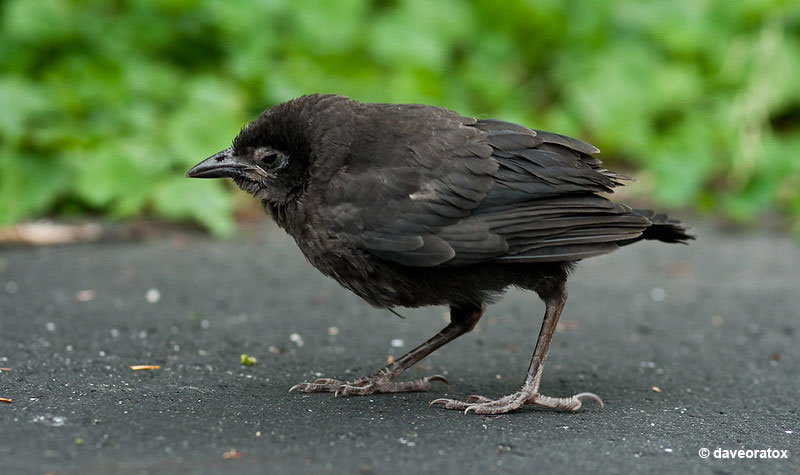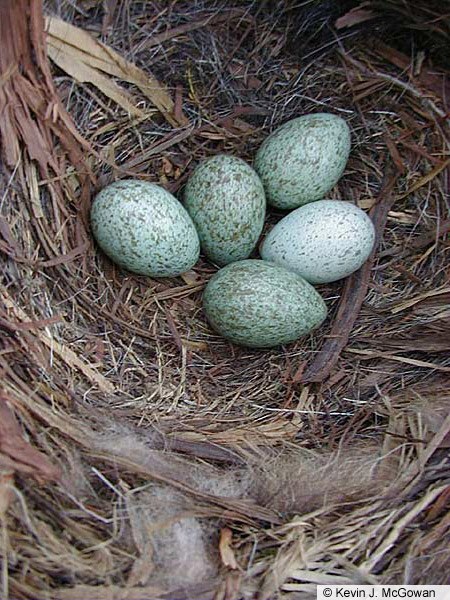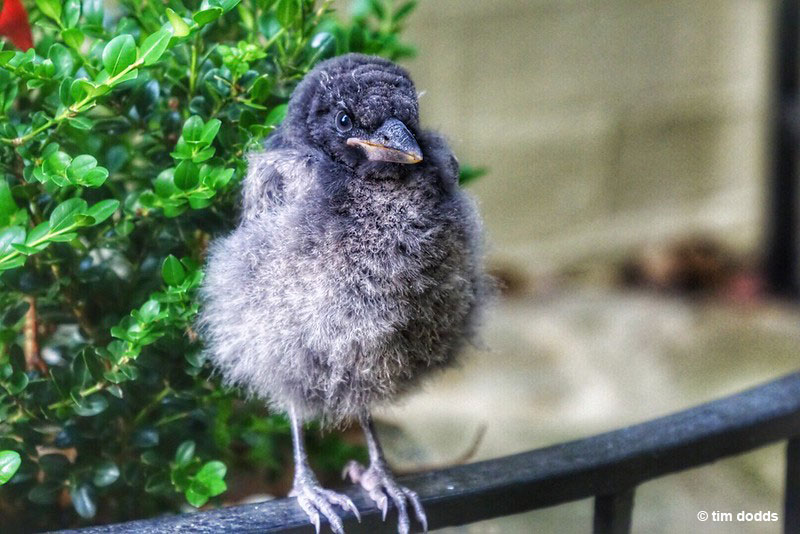
Crows are quite common across the United States, so you have probably noticed this intelligent all-black bird flying around, foraging for food, or just surveying its surroundings. Yet, you’ve most likely not seen one of them as a baby. Have you ever wondered why?
This is mostly because Crows hide their nest high up a tree and once hatched, the chicks grow quite quickly, and by the time you see one, they’re most likely already juveniles.
Are you interested to learn more about baby Crows, their nest, and their diet? Read on!
On this page
Nest
A Crow’s nest is a large bulky basket made of medium-sized sticks, twigs, and strips of bark lined with softer and finer plant material, moss, and feathers. It is built somewhere high up a tree on a branch near the trunk or in a vertical fork.
The nests rarely survive more than one breeding season, but if the spot was favorable, then the pair might return and build their nest in the same space.

American crow nest and eggs
The female lays 3-9, on average 4-6 dull greenish-blue to grayish-green eggs that are speckled with brown and gray. The eggs are 1.4-1.9 inches long and 1-1.2 inches wide. In most cases, the female Crow incubates them alone for 16-18 days. The male bird or the helpers bring her food.
For some time, the Crow hatchlings are completely helpless and clumsy and dependent on their parents to feed them. They stay in the nest for about a month or so.
They can’t properly fly for about another week, so they perch on a lower branch or hide somewhere near the nest until they gather their strength.
What Do They Look Like
Newly hatched Crows are dark gray, almost naked, blind, and have salmon-pink bills. They can comfortably fit into the palm of your hand and weigh only around 1 ounce but grow rapidly. After 30 days, they are ready to leave the nest.
By the time they’re three weeks old, they will have grown feathers that cover most of the body and at this stage, they’re called nestlings. Their eyes are a bright shade of blue and their pink beak begins to darken. They start to become active and curious about their surroundings.

Photograph © tim dodds
A fledgling Crow is fully feathered but smaller than an adult and has a ruffled, fluffy look about them. Fledgling Crows that have just left their nest have been observed to be uncertain when it comes to flying. After a few days, they’ll gather the needed strength and confidence.
In the meantime, they can look a bit lost and awkward, but in most cases don’t need human intervention. As long as they appear mobile and alert, are covered with feathers, and no immediate danger is nearby, it is best to leave them alone.
Juvenile Crows are very similar to their parents, albeit a bit smaller in size and have duller plumage, and they also have dark blue eyes.
Related: How To Befriend Crows
However, they are far from independent and will remain with their parents for weeks, possibly even months or years. The parents take care of them for a few more months, as this species tends to stick together for the long term.
What Kind Of Food Do Baby Crows Eat?
Baby Crows need close care and attention. For the first two weeks, they eat soft, partially digested food that is regurgitated by their parents or helpers (offspring from previous seasons).
The male typically brings the food whilst the female remains with the young, keeping them warm. Food in this stage consists primarily of meat, as protein is important for the growing chicks.
Related: How rare are albino crows?
After the first two weeks, the nestlings can start eating solid foods, such as larger scraps of meat, beetles, spiders, reptiles, grasshoppers, etc. Even after leaving the nest, the parents help them forage and find food.
Crows are omnivores; their diet includes different fruits and seeds, insects, reptiles, bird eggs, birds, small mammals, fish, etc.
Frequently Asked Questions
What is a baby crow called?
A baby Crow is called a chick.
Can you own a pet crow?
You cannot own a pet Crow, it is illegal. If you find an injured Crow or an abandoned or injured baby Crow, call your local Wildlife Protection Services for further instructions.
Why do we not see baby crows?
We don’t usually see baby Crows because their nest is very well hidden and they grow up quickly. You might, however, see fledgling Crows and juveniles that have just left the nest.
What do I do if I find a baby crow?
If you find a baby Crow, it is covered with feathers, seems unhurt, and alert, and no immediate danger is nearby, it is best to leave it where you found it. It is not abandoned; the parents are nearby.
What do baby crows look like?
Hatchling baby Crows are almost naked, blind, and have a pink bill. Nestling and fledgling baby Crows have bright blue eyes, a shorter and pinkish bill, and their plumage is duller. They also look a bit ruffled.
How do you know if a baby crow needs help?
A baby Crow needs help if it’s in immediate danger, in which case you can gently move it to a nearby bush or tree. If it hasn’t fully feathered yet, has an obvious injury, is covered in flies, or the parents haven’t been around for 4 hours, give a call to your local Wildlife Protection Services. Otherwise, leave it alone.
How long does a baby crow stay with its mother?
Baby Crows stay in the nest for about 30 days, but still depend on their parents for food for a few weeks or even months after that. Crows form strong relationships, so it is possible that an offspring won’t leave the family unit at all.

Rose
Wednesday 24th of April 2024
We have been so blessed to have the same 2 crows visit yearly for several years now. We named them Edith and Edgar. We have seen them feed their young on the ground, once they started leaving the nest. I also watched Edith weaning a disgruntled young one who wanted to be fed by her,but he eventually started to eat on his own and stopped squaking lol.I also didn't know that the young ones play together! The one will step on the other ones tail,and the one that got stepped on falls on its back then gets up and they do it again. It's so cute!
Patrick O'Donnell
Wednesday 24th of April 2024
@Rose- How wonderful to have those same crows visit and watch their antics!
Mary
Wednesday 27th of March 2024
Ho long do baby crows cry to be fed?
Patrick O'Donnell
Friday 29th of March 2024
@Mary- Baby crows cry to be fed while they are in the nest and may continue to beg for food for several days after. They leave the nest around 32 days after hatching.